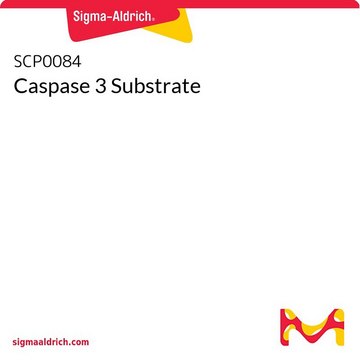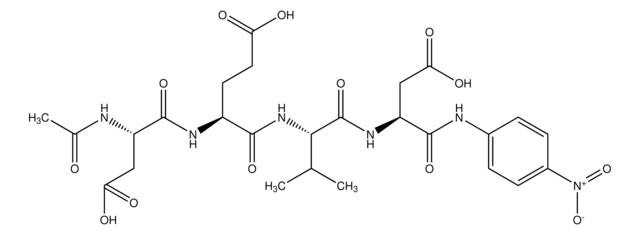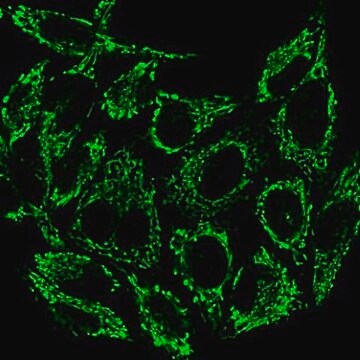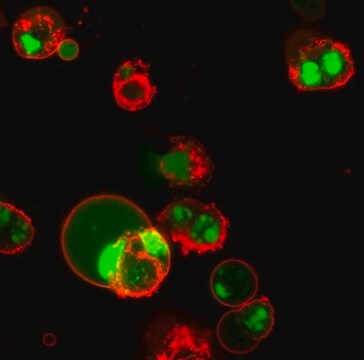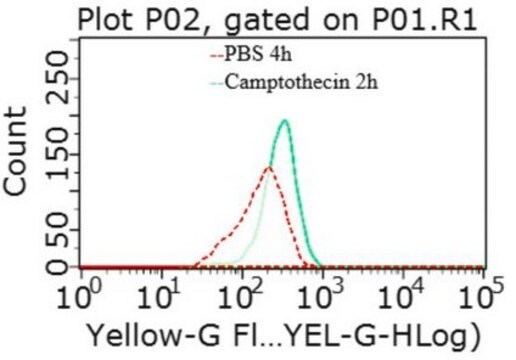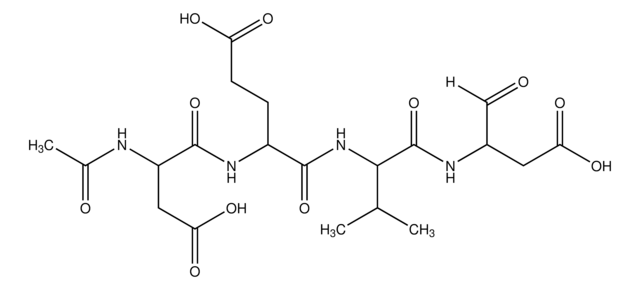235400
Caspase-3 Substrate I, Colorimetric
Colorimetric substrate for caspase-3 (Km = 9.7 µM) and related cysteine proteases.
Synonym(s):
Caspase-3 Substrate I, Colorimetric, Ac-DEVD- pNA, Ac-DEVD-pNA
Sign Into View Organizational & Contract Pricing
All Photos(1)
About This Item
Empirical Formula (Hill Notation):
C26H34N6O13
CAS Number:
Molecular Weight:
638.58
UNSPSC Code:
12352200
Recommended Products
Assay
≥95% (HPLC)
form
lyophilized
manufacturer/tradename
Calbiochem®
storage condition
OK to freeze
desiccated
protect from light
solubility
DMSO: 60 mg/mL
shipped in
ambient
storage temp.
−20°C
General description
Colorimetric substrate for CPP32/Apopain/Yama (Km = 9.7 µM) and related cysteine proteases. Sequence is based on the P1-P4 tetrapeptide cleavage site of poly (ADP-ribose) polymerase (PARP) and includes Asp216. CPP32 is the protease responsible for the cleavage of PARP. Can be used with Pro-caspase-3 in in vitro assays to measure caspase-9 activity, since caspase-9 activates pro-caspase-3. Cleavage of the substrate can be monitored at 405 nm (ε = 9160 cm-1M-1).
Colorimetric substrate for caspase-3 (Km = 9.7 µM) and related cysteine proteases. Sequence is based on the P1-P4 tetrapeptide cleavage site of poly(ADP-ribose) polymerase (PARP) and includes Asp216. Caspase-3 is the protease responsible for the cleavage of PARP. Also a substrate for caspase-6, caspase-7, caspase-8, and caspase-10. Cleavage of pNA is monitored colorimetrically at ~405 nm.
Biochem/physiol Actions
Cell permeable: no
Km = 9.7 µM as colorimetric substrate for caspase-3
Primary Target
Caspas-3
Caspas-3
Product does not compete with ATP.
Reversible: no
Warning
Toxicity: Standard Handling (A)
Sequence
Ac-Asp-Glu-Val-Asp-pNA
Reconstitution
Following reconstitution, aliquot and freeze (-20°C). Stock solutions are stable for up to 6 months at -20°C.
Other Notes
Cardone, M.H., et al. 1998. Science 282, 1318.
Thornberry, N.A., and Lazebnik, Y. 1998. Science 281, 1312.
Nicholson, D.W., et al. 1995. Nature376, 37.
Lazebnik, Y.A., et al. 1994. Nature371, 346.
Thornberry, N.A., and Lazebnik, Y. 1998. Science 281, 1312.
Nicholson, D.W., et al. 1995. Nature376, 37.
Lazebnik, Y.A., et al. 1994. Nature371, 346.
Legal Information
CALBIOCHEM is a registered trademark of Merck KGaA, Darmstadt, Germany
Storage Class Code
11 - Combustible Solids
WGK
WGK 1
Flash Point(F)
Not applicable
Flash Point(C)
Not applicable
Certificates of Analysis (COA)
Search for Certificates of Analysis (COA) by entering the products Lot/Batch Number. Lot and Batch Numbers can be found on a product’s label following the words ‘Lot’ or ‘Batch’.
Already Own This Product?
Find documentation for the products that you have recently purchased in the Document Library.
Konrad A Szychowski et al.
Pesticide biochemistry and physiology, 168, 104638-104638 (2020-07-28)
Triclosan (TCS) is commonly used worldwide in a range of personal care and sanitizing products. A number of studies have revealed the presence of TCS in human tissues. It has recently been shown that TCS can interact with AhR in
Our team of scientists has experience in all areas of research including Life Science, Material Science, Chemical Synthesis, Chromatography, Analytical and many others.
Contact Technical Service